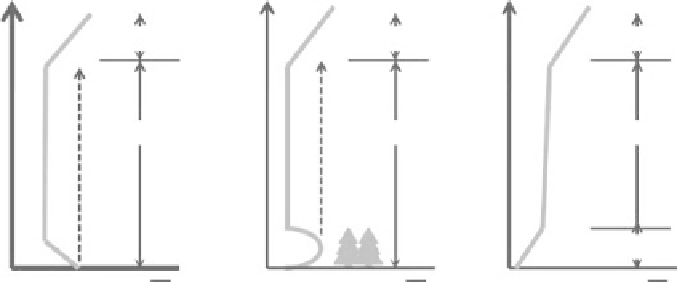Geoscience Reference
In-Depth Information
w
q
q
(
′
′
)
v
g
v
(19.1)
R
i
=
⎛
⎞
⎛
⎞
∂
u
∂
u
∂
u
∂
∂
∂
w
w
w
uu
uv
uw
wu
wv
ww
+
+
+
+
+
(
′′
)
(
′′
)
(
′ ′
)
(
′′
)
(
′′
)
(
′ ′
)
⎜
⎟
⎜
⎟
∂
x
∂
y
∂
z
∂
x
∂
y
∂
z
⎝
⎠
⎝
⎠
If
R
i
is also evaluated over a flat, homogeneous area and in an atmos
p
here with no
subsidence, terms in Equation (19.1) that involve
(
∂∂
x
)
,
(
∂∂
y
)
and
w
are zero and
the equation simplifies to:
w
q
q
(
′
′
)
v
v
g
R
=
(19.2)
i
∂
∂
u
uw
(
′
′
)
z
The sign of the Richardson Number depends on atmospheric stability. In the ABL,
momentum flux is toward the surface, i.e.,
(
uw
′
≤
0
but the mean wind speed in
′
)
the X direction increases with height so
uz
. Consequently, the denominator
in Equation (19.2) is negative. The value of
R
i
is th
erefore negative in unstable
(daytime) conditions when the buoyancy flux,
∂∂>
0
w
′′
q
, is positive, but it is positive
in stable (nighttime) conditions when the buoyancy flux is negative.
An alternative 'gradient' from of the Richardson number,
R
i
g
, is sometimes
defined from the locally measured gradients of virtual potential temperature and
wind speed by assuming that these two gradients are proportional to the buoya
ncy
and momentum fl
u
xes, respectively. The differences in potential temperature,
v
Δ
q
,
v
and wind speed,
u
, might also be used to estimate
the gradients. The definition of the
gradient Richardson number
is:
Δ
, over the same height range,
z
Δ
Figure 19.1
Simplified
profiles typical of potential
temperature for (a) the
daytime ABL over short
vegetation or soil; (b) the
daytime ABL over tall
vegetation; and (c) the
nighttime ABL over short
vegetation or soil, illustrating
that there is often
inconsistency between actual
atmospheric stability in the
ABL and that expected from
the gradient form of the
Richardson number that is
derived from the gradient of
virtual potential temperature.
(a)
(b)
(c)
Z
Z
Z
Stable
Stable
Stable
Unstable
Unstable
Unstable
Stable
q
v
q
v
q
v



















